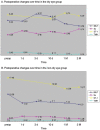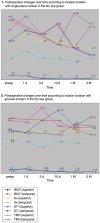Dry eye after cataract surgery and associated intraoperative risk factors
- PMID: 19568353
- PMCID: PMC2694295
- DOI: 10.3341/kjo.2009.23.2.65
Dry eye after cataract surgery and associated intraoperative risk factors
Abstract
Purpose: To investigate changes in dry eye symptoms and diagnostic test values after cataract surgery and to address factors that might influence those symptoms and test results.
Methods: Twenty-eight eyes from 14 patients with preoperative dry eye (dry eye group) and 70 eyes from 35 patients without preoperative dry eye (non-dry eye group) were studied prospectively. In each group, we measured values such as tear break-up time (tBUT), Schirmer I test (ST-I), tear meniscus height (TMH), and subjective dry eye symptoms (Sx), and evaluated the postoperative changes in these values. We also evaluated the influence of corneal incision location and shape on these values. The correlations between these values and microscopic light exposure time and phacoemulsification energy were investigated.
Results: In the dry eye group, there were significant aggravations in Sx at 2 months postoperatively and in TMH at 3 days, 10 days, 1 month, and 2 months postoperatively, compared with preoperative values. All dry eye test values were significantly worse after cataract surgery in the non-dry eye group. With regard to incision location, there was no difference in tBUT, Sx, ST-I, or TMH in either the dry eye group or the non-dry eye group at any postoperative time point. Regarding incision shape, there was no difference in tBUT, Sx, ST-I or TMH at any postoperative time point in the dry eye group. In the superior incision sub-group of the non-dry eye group, tBUT and Sx were worse in the grooved incision group at day 1. In the temporal incision sub-group of the non-dry eye group, Sx were worse in the grooved incision group at 1 day, 3 days, and 10 days postoperatively. In both groups, significant correlations were noted between microscopic light exposure time and dry eye test values, but no correlation was noted between phacoemulsification energy and dry eye test values.
Conclusions: Cataract surgery may lead to dry eye. A grooved incision can aggravate the symptoms during the early postoperative period in patients without dry eye preoperatively. Long microscopic light exposure times can have an adverse effect on dry eye test values.
Keywords: Cataract surgery; Dry eye.
Figures





References
-
- Hiroko BM. Cataract Surgery in the Presence of other ocular comorbidities. In: Steinert RF, editor. Cataract Surgery: Technique, Complication and Management. Saunders; 2004. chap. 32.
-
- Jagat R, Amit G, Gagandeep SB, et al. Outcomes of phacoemulsification in patients with dry eye. J Cataract Refract Surg. 2002;28:1386–1389. - PubMed
-
- Xue-Min Li, Lizhong H, Jinping H, Wei W. Investigation of dry eye disease and analysis of the pathologic factors in patients after cataract surgery. Cornea. 2007;26:S16–S20. - PubMed
-
- Kohlhaas M. Corneal sensation after cataract and refractive surgery. J Cataract Refract Surg. 1998;24:1399–1409. - PubMed
-
- Ang RT, Dartt DA, Tsubota K. Dry eye after refractive surgery. Curr Opin Ophthalmol. 2001;12:318–322. - PubMed
Publication types
MeSH terms
LinkOut - more resources
Full Text Sources

